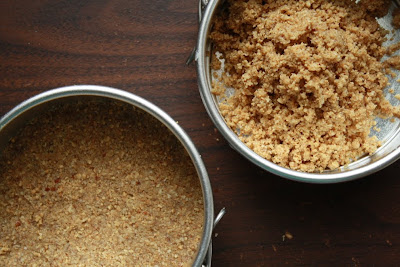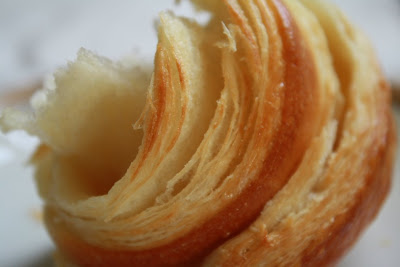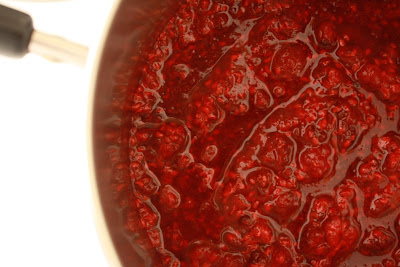Several months ago in the July/August 2009 Cucina Italiana, I saw a picture of peach slices and sorbet garnished with ribbons of basil. I could only assume it was the sorbetto di limone e basilico su letto di pesche, or, as I learned from the ever helpful translation, lemon and basil sorbet with peaches. That sounded good enough, but having a hard time getting behind any dessert that doesn't somehow incorporate heavy cream, I decided it needed to be accompanied by basil ice cream.
The sorbet was good, the peaches (the first from my fall fruit share) were excellent, but the ice cream was divine. The sorbet would shine, I think, as an intermezzo, but for dessert give me the ice cream. At first it's just pure, creamy, not too sweet heaven and then at the end you get the basil flavor, which goes very nicely indeed with the sweet tartness of the peaches.
Basil Ice Cream
adapted from Fine Cooking, Issue 99
- 2 cups heavy cream
- 1 cup whole milk
- 3/4 cup sugar
- salt
- 6 egg yolks
- 1 packed cup basil leaves, roughly torn
- Mix 1 cup of the cream with the milk, sugar, and a pinch of salt in a medium sauce pan and place over medium heat. Warm the mixture, stirring occasionally, until the sugar is completely dissolved and small bubbles begin to form around the edge of the pan. Remove from heat and add the roughly torn basil leaves. Cover and let stand for 1 hour, or until flavor has achieved desired intensity.
- Just before the hour is up, get your yolks ready in a medium bowl.
- Remove basil leaves by either straining the mixture or scooping them out with a slotted spoon (or by any other method that suits your circumstances). Place mixture back over medium heat and warm until small bubbles once again form at the edge of the pan. Remove from heat and temper your yolks by pouring half the cream mixture over the egg yolks, whisking constantly as you do so.
- Pour the yolk mixture back into the pan and cook over low heat, stirring constantly, until the custard thickens slightly and coats the back of a spoon and is able to hold a line drawn through it with a finger.
- Have the remaining cup of cream ready in a medium bowl. When your custard mixture is ready, pour it through a strainer into the bowl holding the cream. Mix well and place a piece of plastic wrap on the surface of the custard, excluding any air bubbles, so a skin does not form. Place in the refrigerator for several hours until completely chilled.
- [Alternately, you can place the remaining cup of cream in a metal bowl in an ice bath, strain the custard into that and stir the mixture until cool, then refrigerate. This will save you some time.]
- Once the custard is cool, freeze in an ice cream maker according to the manufacturer's instructions. At this point the ice cream willresemble soft serve. Transfer to air tight containers and freeze until solid, 4 hours or so. Allow to stand at room temperature 10 minutes before attempting to scoop.
Makes one quart creamy deliciousness.
Lemon-Basil Sorbet
adapted from La Cucina Italiana, July/August 09
- 2 cups water
- 1 cup sugar
- 10 basil leaves, roughly torn
- zest and 2 Tbs. juice of one lemon
- Combine water and sugar in a small heavy saucepan and cook over medium heat, stirring, until sugar has dissolved. Remove from heat and stir in basil leaves. Cover and let stand until cooled to room temperature, about an hour.
- Once syrup is cool remove and discard basil leaves. Add lemon zest and juice. Refrigerate until completely chilled, or quick chill in an ice bath.
- Freeze in ice cream maker according to manufacturer's instructions. Transfer sorbet to airtight container and freeze until solid, at least 3 hours. Allow to stand at room temperature 10 minutes before scooping.
Makes one pint.
Tuile cups are something I've been wanting to make for a while and they seemed fine vessels to hold my frozen basil desserts. They could just as easily be made into cones by rolling them into a cone shape when they come out of the oven instead of draping them to form little bowls.
Tuile Cups
- 1/4 cup butter
- 1/2 cup powdered sugar, sifted
- splash vanilla
- 2 egg whites, lightly beaten with a fork
- 1/2 cup flour, sifted
- Either by hand or at low speed in a stand mixer fitted with the paddle attachment, cream butter, sugar, and vanilla to a paste. Gradually add the egg whites while still stirring. Add the flour a little at a time and stir to make a smooth batter, being careful not to over-mix.
- If decorating cups, reserve a small amount of the batter and add to it a drop of the food coloring of your choice.
- Cover batter and chill in the refrigerator for 30 minutes. Preheat oven to 350°F.
- Line a baking sheet with a silicon mat and, using a 6-inch circle template, spread out an even layer of batter. Carefully remove the template and repeat until you can fit no more cookies on your sheet. Place colored batter in a pastry bag and pipe lines on the circles.
- Bake for 7-10 minutes, or until the edges turn golden brown. Remove immediately from silicon mat and drape over a mug or bowl to form the cup. You may have to train it somewhat with your fingers. Store in an airtight container until ready to use.

































